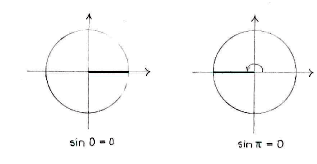Lösung 4.4:2c
Aus Online Mathematik Brückenkurs 1
(Unterschied zwischen Versionen)
K |
K (Robot: Automated text replacement (-{{Displayed math +{{Abgesetzte Formel)) |
||
| Zeile 5: | Zeile 5: | ||
We get the full solution when we add multiples of <math>2\pi</math>, | We get the full solution when we add multiples of <math>2\pi</math>, | ||
| - | {{ | + | {{Abgesetzte Formel||<math>x = 0+2n\pi\qquad\text{and}\qquad x = \pi + 2n\pi\,,</math>}} |
where ''n'' is an arbitrary integer. | where ''n'' is an arbitrary integer. | ||
| Zeile 12: | Zeile 12: | ||
Note: Because the difference between <math>0</math> and <math>\pi</math> is a half turn, the solutions are repeated every half turn and they can be summarized in one expression, | Note: Because the difference between <math>0</math> and <math>\pi</math> is a half turn, the solutions are repeated every half turn and they can be summarized in one expression, | ||
| - | {{ | + | {{Abgesetzte Formel||<math>x=0+n\pi\,,</math>}} |
where ''n'' is an arbitrary integer. | where ''n'' is an arbitrary integer. | ||
Version vom 08:58, 22. Okt. 2008
There are two angles in the unit circle, \displaystyle x=0 and \displaystyle x=\pi, whose sine has a value of zero.
We get the full solution when we add multiples of \displaystyle 2\pi,
| \displaystyle x = 0+2n\pi\qquad\text{and}\qquad x = \pi + 2n\pi\,, |
where n is an arbitrary integer.
Note: Because the difference between \displaystyle 0 and \displaystyle \pi is a half turn, the solutions are repeated every half turn and they can be summarized in one expression,
| \displaystyle x=0+n\pi\,, |
where n is an arbitrary integer.

